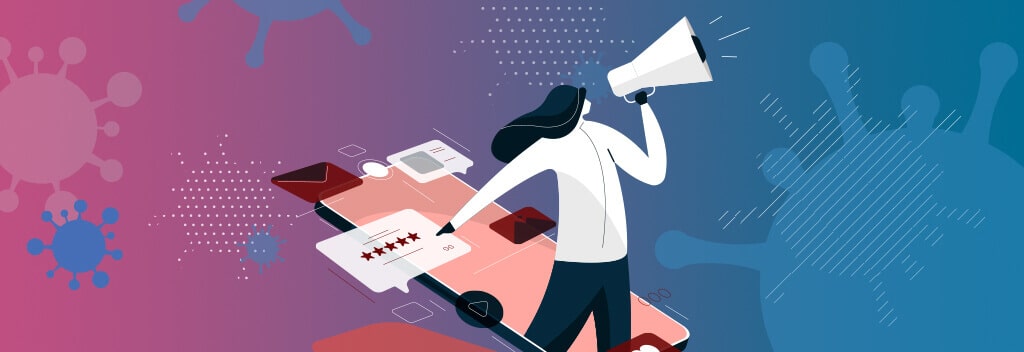You don’t need us to tell you that 2020 changed pretty much everything, from the way you think about social gatherings, to how you get your groceries, to what you think about teachers (their job is hard!), to how you manage your day-to-day work life. Along with everything else that changed in 2020, B2B marketing made a huge shift!
In this blog, we take a look at how last year changed how we market for B2B firms.
Heavy Shift to Digital Channels
As you are aware, everything shut down to varying degrees in 2020, regardless of where you are located. Conferences were canceled, networking events went virtual, and many B2B companies went strictly remote and stopped allowing visitors on-site. With all of these changes, we saw a heavy shift from in-person marketing channels to digital marketing channels.
Companies that were already using digital marketing channels started to lean on them even more. Companies that only used digital marketing occasionally suddenly embraced digital as their new avenue for marketing. Companies that never did digital marketing started scrambling to get up and running online.
The great thing about digital marketing channels is that they work for every type of business and industry where B2B companies operate. There may be some channels that work better than others, but digital marketing works. Why? Because you are meeting your ideal prospect where they are looking for your products and services – online.
Read more: B2B website must-haves for 2021.
Timely Engagements
During 2020, many things were delayed or slowed down due to the pandemic. Shipping was slower, materials were scarce, factories kept having to shut down, etc. However, while we all started experiencing major logistical delays for products, services started ramping up and we experienced more timely engagements.
How did this change B2B marketing? Companies had to start becoming more nimble, flexible, and responsive. The amount of time it takes you to respond to a website lead or a live chat request can truly get you the deal. I know this sounds like the opposite of what you may have expected, but it’s true.
Why did this happen? With everything your prospects are juggling these days (remote learning, babysitting, managing their internal teams remotely, duties they may have previously outsourced), they don’t have time to sit around and wait for a response. They need answers quickly or they are moving on. Timely, responsive responses and engagements in marketing are now essential.
Read more: What happens to your B2B marketing leads after they are qualified.
Personalization Really Matters
One thing the pandemic taught us was not to put up with any extra noise. All clutter – both digital and real – had to go. For this reason, you need to be thoughtful about every communication or touchpoint with a prospect. If you aren’t creating a clear connection or speaking to their needs, they will likely ignore your message or delete it altogether.
There is also a psychological element here. Keep in mind that many companies and their employees are fully remote, so there is little human contact. As such, any contact, like an email newsletter or a post needs to be humanized and create a connection. Just blasting blogs out on social media without any context won’t create any connections with your audience. Whenever possible, communications should also be personalized and not automated.
For B2B marketing, this impacts a lot of automations that marketers rely on. Instead of setting up automated lead nurturing, or client updates, or outbound campaigns, marketers need to shift and become very thoughtful and intentional in all communications. The person you are trying to connect with today doesn’t have the same needs or environment that they did in 2019. Campaigns that were personalized resonated better with the target audience.
Read more: Automation vs personalization in sales.
Flexible Strategies
For better or for worse, 2020 taught every single B2B marketer to be flexible. While it’s good to have a strategy, it’s better to have a flexible strategy or nimble approach. The conference you rely on all year for great leads may go virtual or have poor attendance. Your biggest source of referral traffic may go out of business. The sales team may be emailing you more often asking how to generate more leads.
A flexible strategy with a variety of moving parts enables you to adapt and shift focus as necessary. (I refuse to say PIVOT!!!). While you can’t plan for the unexpected, you can certainly come up with a few alternate ideas. Now is a good time to test out a strategy that may not have worked in the past but is more applicable now.
A great example is content marketing. We’ve found over the past year that when many businesses are mostly remote, subject matter experts (SMEs) are able to make more time to help create blogs. We’ve even found that former SMEs who were reluctant to participate in content creation are now huge proponents! Amazing.
Less Polish, More Connections
Let’s face facts. Even though you may be reading this at 1pm on a Tuesday at your work computer, there is a 90% chance you are wearing pajama pants. They may even be your “work PJs,” you know, the ones you put on when you get out of bed because you do want to feel accomplished at changing. Even if you are wearing real jeans, or khakis, or even a suit as you read this, you must admit that 2020 helped us all to become more real.
We’ve all seen a shirtless toddler run past a person presenting a pitch, or a cat jump up onto a desk during a company meeting, or even a coworker who refuses to go on video because it was a last-minute meeting and they didn’t brush their hair yet. Yes, some of these may be extreme and may be falling by the wayside as we settle in, but the truth is that none of us are expecting 100% professional only demeanors from our vendors, clients, or coworkers.
After the entirety of last year, many people are OK with less polish and a more human connection. In fact, many prefer connection over polish. Yes, it’s great to see a nicely designed digital ad or newsletter banner, but it’s nicer to read something that we feel personally resonates with us and our daily struggle. This doesn’t mean that professionalism is gone, it just means that it’s time to “get real.” People want to connect with you and your brand. Creating genuine connections is critical to B2B marketing going forward.
That’s our perspective on how B2B marketing has shifted after the whirlwind of 2020.



